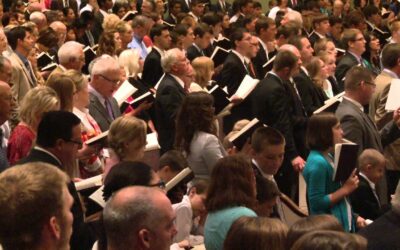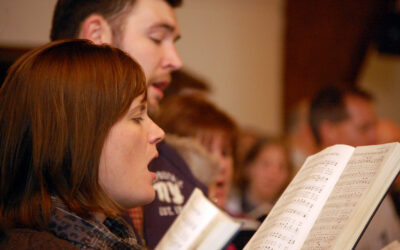The body of Christ is a family, and in this family we have fellowship with one another as The Church—all faithful believers throughout the world—and the church, our own local congregation. Fellowship is a crucialpart of the body of Christ. It’s the fundamental basis of the church as a community. Fellowship is where we engage with other believers and help them along the way. Fellowship is where we care for others, where we rejoice when they’re celebrating, and we weep when they’re mourning. We are the body of Christ and the body of Christ is a fellowship.
The early church understood the importance of fellowship. They would gather together in the synagogue or in the temple to worship. But then they would come together on another day, Sunday, to fellowship with other believers in Christ. And in these times of fellowship they would have a meal and observe the Lord’s Supper.
The churches that worship in the historic traditions (the Anglicans, Catholics, Episcopalians, and Lutherans) have somewhat maintained this early church idea of worship and fellowship being separate. These churches have combined the two ideas into one service divided into two main sections: the Service of the Word (which include the components of revelation, adoration, confession, expiation, and proclamation) and Service of the Table where they celebrate the Lord’s Supper (an act of proclamation) as well as dedication. Historically the Service of the Word would be for anyone who desired to attend but the Service of the Table would be only for the baptized followers of Christ. Those who attended the service of the word who were not baptized believers would be dismissed at the conclusion of that part of the service so that only the believers would participate in the Service of the Table. The churches that worship in the historic traditions mimic the early church’s idea of worship and fellowship being two separate events. But between the Service of the Word and the Service of the Table there is a brief time of fellowship and focus on fellowship activities. The greeting time is called “the passing of the peace” where each congregation member will welcome those around them by saying “the peace of the Lord . . . ” or simply “peace.” After this the congregation will be seated and have a time to focus on the activities of the life of the church family. Evangelical Protestants don’t really have that clean distinction between those two parts of the life of the church. Although they may share some of the same ideas they’re much more blurred, they’re not as clear cut in the Evangelical and Protestant church.
When we think about worship and the place fellowship has in the local church we need to build our foundation of understanding on the idea of a distinction between the two. Worship is something that we do WITH the fellowship—the church family—but fellowship is not the focus of worship. Worship is for God. It focuses on God. Fellowship focuses on each one of us, our friends, our fellow believers in Christ, those of us who are in our church family. Worship is a time that we spend together as a fellowship but it is not a time we spend together to focus on the fellowship. Worship is a time that we, together, as a fellowship, focus on God, not on each other. Worship is fellowship with GOD. Worship is not us. Worship is for God. God is the object of our worship. We, our fellowship, are not the object of our worship. It’s unfortunate that many, many churches today build their worship around the believers and their needs or desires. Worship is not for us. Worship is for God. It is our focusing on God not us focusing on each other.
If we focus on fellowship (which is incredibly important in the body of Christ), we almost made fellowship an idol—we make that fellowship the object of our worship. Fellowship, yes, is a very good and important thing but it is not the goal of worship. Evangelism is also incredibly important. We are commanded by Christ to “go into all the world and preach the gospel to every creature.” But evangelism is not worship. And when evangelism or fellowship become the dominant or most important goals of worship we have made those two things almost into idols. God is the object of our worship, not fellowship.
The best practices of traditional worship allows for a time where we focus on fellowship activities. But we don’t focus on fellowship activities during worship. The fellowship activities belong BEFORE worship and should continue AFTER worship but they’re not the focus of worship.
What then should we call this period of focus on fellowship activities? There are a number of possibilities including simply labeling it “fellowship time” or “Focus on the Family” (with profound gratitude from the existing national ministry of the same name!). But an option I like is to label it “The Gathering” where we, as a local body of Christ, gather together in the worship space to take care of the business of fellowship. If you’ll remember in a previous post we made a distinction between “sacred time”—the brief one hour period of corporate worship on Sunday morning—and “secular time”—the six days and 23 hours of the rest of the week. By placing fellowship activities, “The Gathering,” before the service it places those “secular” items in “secular time” and separates them from the worship of God in “sacred time.”
The Gathering then would be the time we make announcements, recognitions, introductions of special guests, share joys and concerns of the congregation, acknowledge birthdays, anniversaries, rejoice with families celebrating the birth of a new child, and mourning with families that have lost loved ones. All of these are fellowship activities. But notice that prayer, intercession, thanksgivings are acts of worship and they belong in sacred time—in the time of worship. So praying for families who are mourning, rejoicing with families who are celebrating—these things can be prayed for in worship but can be announced during The Gathering. The Gathering can also be used to make notes or give instructions regarding worship that day. If there is some change in the normal worship order for which the congregation needs to be forewarned or instructed on how to navigate the change The Gathering is the place to give alerts, not the middle of worship.
Another great way to use The Gathering is to have a congregational rehearsal where you teach your congregation new songs (as the Psalms tell us to “sing a new song to the Lord”) to prepare them to use that new song in worship at a later date. In this use of The Gathering you could ing one verse of a new hymn each week for several weeks before you plan to use it in worship. That way you’re giving them time to learn it so that when they use it in worship they have had the opportunity to learn it.
There is also a practical function for The Gathering for it becomes a crowd calmer. If you’re in most Evangelical Protestant churches you’ll find that the time before worship is typically rather lively. Members of the congregation will greet one another as they enter the worship space and there will probably be a lot of conversation going on. But The Gathering will help calm the crowd, if you will, to get them ready for worship by bringing them together gradually. Training a congregation to know when The Gathering is beginning is important to its success. Some ways to help to communicate “hey! Something is getting ready to happen” is to have all of the worship leaders assemble in the chancel to signal “it’s time to quite down, someone’s about to speak.” Perhaps the “minister of announcements,” the pastor, or a lay worship leader could simply greet the congregation and wait for their attention. Or a musical cue of some kind, perhaps a common song, or the ringing of bells or chimes could signal to the congregation that The Gathering has begun.
The Gathering should also be a time when the congregation is invited to stand and greet those around them, particularly guests. But the best part about The Gathering is that it allows you to verbally focus the congregation on the worship that’s about to come by giving a focus sentence such as “today’s worship is on the faithfulness of God. Let’s prepare ourselves for worship.” Or something a bit more formal like “lift up your hearts” with the congregation responding “we lift them up to the Lord” could be useful as a focus sentence. This, then, sets up the prelude, then as preparation for worship.
There are a number of other things that can be said about fellowship and worship. Share your ideas in the comments below. We’ll compile these and present them in a future post.
_______________
Sacred Song Consulting exists solely to help congregations refine, revitalize, and reform traditional worship for contemporary people. We are a resource for all worship leaders. We are a guide to lead you to the best practices of traditional worship. We provide you with the tools to plan, prepare, and lead traditional worship, the nuts-and-bolts concepts that help traditional worship honor God and enrich the congregation. We are here to help you! You are not alone in your desire to have transformative worship in your congregation. Reach out to us. Let us know how we can help you!



0 Comments